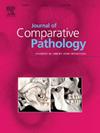鸟类喙部瘤变:附9例报告
IF 0.9
4区 农林科学
Q4 PATHOLOGY
引用次数: 0
摘要
鸟喙瘤变在鸟类中是一种罕见的疾病,通常在鹦鹉形目中报道。通过多机构回顾性研究,我们描述了9例鸟喙瘤变病例,这些鸟喙瘤变病例来自6个物种,分别属于鹅形目(Gallus Gallus domesticus和Syrmaticus reevesii)、鹦鹉形目(Amazona sp和Ara sp)、雁形目(Anas platyrhynchos domesticus)和Columbiformes (Columbina livia domestica)。性别分布为4名女性,4名男性和1名未指定。诊断时的平均年龄为11.8岁(范围2-38岁;标准差±12.8年)。最常见的肿瘤是鳞状细胞癌,其次是黑色素瘤;两例肿瘤均有转移。其他诊断的肿瘤包括未分化癌、脂肪瘤和纤维肉瘤。大多数肿瘤位于上颌颊腺(66%;6/9)。临床表现为慢性体重减轻、厌食、缺氧、食欲不振、吞咽困难、喙角广泛溃疡、继发细菌感染、口臭、异物嵌塞、呼吸困难。影响鸟喙的肿瘤的进展从3周到几年不等,导致55%(5/9)的病例安乐死。本文章由计算机程序翻译,如有差异,请以英文原文为准。
Beak neoplasia in avian species: description of nine cases
Beak neoplasia is a rare condition in avian species and is most often reported within the order Psittaciformes. Through a multi-institutional retrospective study, we describe nine cases of beak neoplasia from six species belonging to the orders Galliformes (Gallus gallus domesticus and Syrmaticus reevesii), Psittaciformes (Amazona sp and Ara sp), Anseriformes (Anas platyrhynchos domesticus) and Columbiformes (Columbina livia domestica). The sex distribution was four females, four males and one not specified. The average age at the time of diagnosis was 11.8 years (range 2–38 years; standard deviation ± 12.8 years). The most commonly reported tumour was squamous cell carcinoma, followed by melanoma; metastases were documented in both neoplasms. Other diagnosed neoplasms included undifferentiated carcinoma, lipoma and fibrosarcoma. Most neoplasms were located at the maxillary rhamphotheca (66 %; 6/9). Clinical signs included chronic weight loss, anorexia, hyporexia, inappetence, dysphagia, extensive ulceration of the beak keratin, secondary bacterial infection, halitosis, crop impaction and dyspnoea. The progression of neoplasms affecting the beak varied from 3 weeks to several years, leading to euthanasia in 55 % (5/9) of the cases.
求助全文
通过发布文献求助,成功后即可免费获取论文全文。
去求助
来源期刊
CiteScore
1.60
自引率
0.00%
发文量
208
审稿时长
50 days
期刊介绍:
The Journal of Comparative Pathology is an International, English language, peer-reviewed journal which publishes full length articles, short papers and review articles of high scientific quality on all aspects of the pathology of the diseases of domesticated and other vertebrate animals.
Articles on human diseases are also included if they present features of special interest when viewed against the general background of vertebrate pathology.

 求助内容:
求助内容: 应助结果提醒方式:
应助结果提醒方式:


